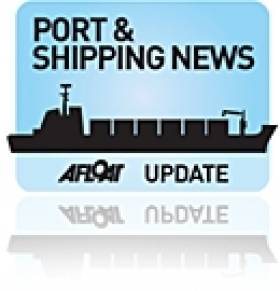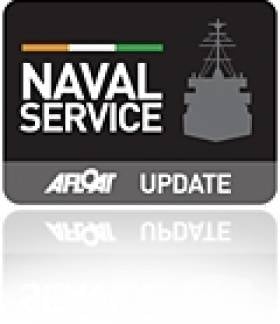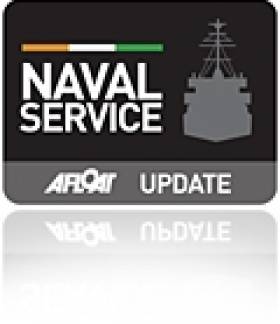Displaying items by tag: Navy News
Ports & Shipping Review: Manx Route Opens, Toxic Cargo-ship Leak, Replenishment at Sea, Cruise Callers, Ferry Festive Boost, Arklow Newbuild and much more
#PORTS & SHIPPING REVIEW - Over the last fortnight Jehan Ashmore has reported from the shipping scene where the Manx-UK winter operated Douglas-Liverpool (Birkenhead) route resumed service.
The port of Warrenpoint on Carlingford Lough was where 18 people suffered injuries arising from a toxic gas leak onboard Arklow Meadow, a dry-cargsship which had arrived with a cargo of grain.
For the sixth year in succession the Irish Travel Trade News Travel Awards voted Irish Ferries as Best Ferry Operator of the Year 2012.
A new book New Life for churches in Ireland, has been published and in which features the former Mariners' Church of Ireland, Dun Laoghaire, now home of the National Maritime Museum of Ireland.
Coliemore Harbour on Dalkey Sound (the medieval port for Dublin) is to undergo a survey to access structural damage on behalf of Dun Laoghaire-Rathdown County Council.
The Naval Service was kept busy within the first fortnight of this month with the detention of two foreign registered vessels for alleged breaches of fishing regulations off Castletownbere.
In a first for the Commissioners of Irish Lights and the Naval Service, a joint replenishment at sea (RAS) exercise took place involving the ILV Granuaile and coastal patrol vessel CPV L.É.Ciara (P42).
Killybegs based Sinbad Marine Services have put on sale the SMS Coastal Cat, a 12m survey workboat built locally at the Mooney Boats yard.
In 2013, ten cruise calls are scheduled to visit Dun Laoghaire, bringing around 10,000 visitors and where the 148,528 tonnes giant liner Queen Mary 2 is to make an anchorage call in mid-May.
Dutch owned heavy-lift specialist Abis Shipping are seeking professionals and trainees to work for the expanding company which this month is due delivery of newbuild Abis Dublin.
In an unprecedented move Irish Ferries are to add a third vessel between Dublin-Holyhead during Christmas and New Year periods while Stena Line are to bring back HSS fast-craft operations between Dun Laoghaire-Holyhead.
In what will be a third order for a wind-farm support vessel from Gardline UK has gone to Arklow Marine Services, the 19m newbuild is to be completed in July 2013.
Former ‘Privately’ Owned Offshore Patrol Vessel Visits Dublin Port
#NAVAL VISIT- Having visited Cork last month, The Royal Navy's River class offshore patrol vessel OPV HMS Mersey (P283) is currently moored in Dublin Port, the ship belongs to a trio of sisterships purchased in a £39m deal, writes Jehan Ashmore.
HMS Mersey along with OPV's Severn and Tyne have for nearly the last decade served the Fishery Protection Squadron while on 'loan' to the Royal Navy. They had operated on a rolling five-year term lease from the shipbuilder-owners, Vosper Thornycroft, now part of BAE Systems.
The lease was due to be renewed in 2013 but rather than face having to pay more to rent the trio of vessels for £7m a year, the UK government signed the contract to buy the ships outright, keeping them in service with the Royal Navy for the next ten years.
The Portsmouth based OPV's known as the 'Cod' squadron are hard-working vessels, where each vessel conducts fishery patrol duties for 275 days annually. In addition they are assigned to perform tasks such as maritime security, counter terrorism, tackling smuggling, fire-fighting and SAR missions.
Fishery Detentions off Clare Coast
#FISHERY DETENTIONS – Yesterday the Naval Service OPV L.E. Aisling (P23) detained an Irish registered vessel approximately 125 nautical miles off the coast of Loop Head, Co. Clare. The detention was in relation to an alleged breach of technical fishing regulations.
The vessel was to be escorted by the OPV to arrive in Castletownbere this morning and then and handed over to the Gardaí.
Also earlier this month, the LPV L.E. Niamh (P52) detained another vessel on the same grounds. On that occasion the detained French registered vessel was likewise fishing in waters off Loop Head and taken under escort to the Co. Cork fishing harbour.
According to Naval Service figures, they have carried out 910 boardings, issued 38 warnings and detained 11 vessels so far this year.
Spanish Trawler Detained
#TRAWLER DETENTION - The Naval Service OPV LE Aisling (P23) detained a Spanish registered fishing vessel approximately 175 nautical miles off Mizen Head, Co. Kerry on Wednesday night.
The detention was in relation to an alleged breach of technical fishing regulations and the vessel was escorted by the patrol vessel to Castletownbere and handed over to the Gardai.
So far this year the Naval Service have carried out 498 boardings, issued 25 warnings and detained eight vessels. The total in 2011 was 1,313 boardings and eight detentions of vessels took place off the Irish coast.
Minehunter that Served in Libya Anchors in Dublin Bay
#NAVAL ANCHORAGE – A Royal Navy mine-hunter HMS Bangor (MI09) which took part in Libyan operations last year, anchored overnight in Dublin Bay during the north-easterly gale force winds, writes Jehan Ashmore.
Unlike the majority of vessels which anchor in the south of the bay, she unusually took anchorage north of the main shipping lane for Dublin Port by positioning off Sutton South on Howth Peninsula.
HMS Bangor is a Sandown class mine-hunter and she is due to continue her northbound passage through the Irish Sea to spend Easter at her affiliated namesake town on the shores of Belfast Lough.
Her last call to Bangor was to celebrate Armed Forces Day 2010 and also in that year she called to Dublin, click HERE for that report.
On this occasion she will tell of her role supporting NATO operations off the coast of Libya. During Operation Unified Protector, the mine-hunter's task involved 120 days of non-stop action by scouring miles of sea bed off Libya as the battle between rebels and Colonel Gaddafi raged.
Built in 1999 by Vosper Thorneycroft, Southampton, the glass-reinforced plastic (GRP) ship and her 34 crew undertook the painstaking work. This paid off when the 55m vessel found a 2,400-pound (1000kg) mine and a torpedo lying on the seabed off the port of Tobruk in eastern Libya.
Both were safely destroyed using the ship's Sea Fox system – an underwater drone armed with explosive charges.
HMS Bangor is among seven of her class based at on the Clyde, Scotland. They each displace 600 tonnes and have a range of 2,500 nautical miles. For further details about the class, click HERE.
European Naval Flotilla Docks in Dublin
Of the foursome, only ENS Tasuja is the odd one out, she is a diving and support vessel whereas the rest are all a combination of minehunters / minesweepers. ENS Tasuja is from the Lindormen-class and was built in Denmark in 1977. She is 44.5 meters long, has a maximum speed of 14 knots, and has a crew of 28.
HNoMS Maaloey is an Oksøy-class minehunter which has a catamaran hull constructed of fibre-reinforced plastic which has a very low magnetic signature. She can carry two ROV's and the same number of rigid inflatable boats (RIB).
Above: The Norwegian Navy’s catamaran minehunter HNoMS Maaloey detonates a sea-mine
She is almost identical to the Alta-class leadship HNoMS Alta which provided escort duties during the official state visit of King Harald V and Queen Sonja of Norway, on board the royal yacht K/S Norge in 2006. She arrived in Irish waters, firstly calling to Dun Laoghaire Harbour, where the royal couple boarded the royal yacht at the East Pier. From there she sailed the short distance across the bay to Dublin Port and her last Irish call was to Cork.
ORP Flaming is a mine countermeasures vessel which operates in minesweeping and minehunting. The vessel is designed to trace such devices and make safe fairways for shipping. She can detect anchored mines 1600m from the ship and bottom mines located 600m below the ship's keel. In addition she can lay mines of six different types.
FGS Überherrn is a Kulmbach Class minehunter, in service with the German Navy since commissioning in 1989. She was originally built as a Hameln Class (SM 343) minesweeper by STN Systemtechnik Nord, but was converted to the Kulmbach Class. She has an overall length of 54.4m, a width of 9.2m and a draft of 2.5m and a displacement of 635 tonnes. Armament comprises two, four-cell Stinger missile launchers firing FIM-92 Stinger surface-to-air missiles. There are a crew of 37, which includes four officers, 20 petty officers and 13 ratings.
The flotilla are moored two abreast alongside Sir John Rogersons Quay (berth No. 8), which is located on the south quays between the Samuel Beckett and East-Link Bridges. Of the four naval ships, FGS Überherrn is the first to depart on Sunday, the other vessels are to depart on Monday. The vessels will provide an opportunity to view at close quarters a variety of naval architecture design and navies from northern Europe.
Dutch Naval Stealth Frigate On Visit to Dublin Port
The class have two roles, to command operations and deployment of the Royal Netherlands Navy, the Netherlands Maritime Force (NLMARFOR). In addition they are equipped for air-defence tasks and must be capable of providing protection for an entire fleet.
This dual-role task is the reason that the ships are known as air-defence and command frigates (LCF). The frigates all entered service between 2001-2005 and were built by the Royal Schelde Group, of Flushing, Netherlands. The design also involved participated from Spain and Germany.
It is only in recent years that larger vessels can berth at this stretch of the waterfront following the completion of several major construction projects over the last decade. From the building of the Convention Centre and the Samuel Beckett Bridge which involved using the dredger Hebble Sand (click HERE) during its construction process.
In addition the refurbishment of Spencer Dock sea-lock entrance that for many years was closed is now re-opened. The dock entrance featured in the start of the new television series 'Waterways'-The Royal Canal. Episode two is this Sunday on RTE 1 at 8.30pm.
Aside the 79m L.E. Roisin, the last large vessel to berth close to berth 16A was the French 58m tallship Belem, which was chartered by Alliance Francaise to celebrate their 50th anniversary in 2010 and for the inaugural French Hoist the Sail: Market Festival. The three-masted barque built in 1896 was once also owned by the Sir Arthur Ernest Guinness under the name of Fantôme II.
Situated between where L.E. Roisin is currently berthed and where the Belem had moored, is home to the 'resident' M.V. Cill Airne, a floating bar and restaurant dining venue at berth 16B. Another resident is the former lightship Kittiwake at berth 17B, though sited much further downstream at the end of North Wall Quay, opposite the O2 Arena and next to the East-Link Bridge.
There is a fourth resident, again berthed on the north quays, though the Jeanie Johnston unlike her counterparts is moored closer to the city-centre at Custom House Quay. Apart from yachts, leisure-craft and occasional private motor-yachts using the Dublin City Moorings, she is the only vessel to permanently occupy a berth between Samuel Beckett Bridge and the Sean O'Casey foot-bridge.
- inland waterways
- Dublin Port
- Dublin Docklands
- Royal Canal
- Jeanie Johnston
- naval service
- Custom House Quay
- Alliance Française
- Spencer Dock
- Sean O'Casey Bridge
- River Liffey
- Belem
- Sir John Rogersons Quay
- TallShips
- North Wall Quay
- Fantome II
- Dick Warner
- Dublin City Moorings
- Navy News
- O2 Arena
- EastLink bridge
- LE Roisin
- Sir Arthur Guinness
- National Convention Centre Dublin
- Samual Beckett Bridge
Duke-Class Frigate Docks In Dublin
She measures 133m (436ft) long and on a beam of 16.1m (52.9ft) and has a crew compliment of 185 in total. An array of highly sophisticated arnament is packed on board in addition she can convey a Lynx helicopter. Propulsion is derived from a combined use of diesel and gas (CODLAG) .To read more about the penultimate Type 23 class and her sisters click HERE
Roisin Returns from Russia
In addition the OPV delivered medical supplies on her visit to Riga, the Latvian capital, where the cargo was transported in aid of the Chernobyl Children's Project based in Belarus.






































































